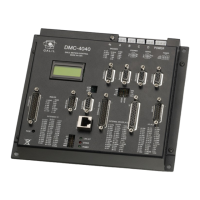1. Check encoder position with the TP command. Ensure the motor is in an MO state and move the motor
manually in the desired positive direction while monitoring TP. If TP reports a smaller, or more negative
number, reverse encoder direction, see Step 6. Connecting Encoder Feedback, pg 19.
2. Select which axis will be using sinusoidal commutation by issuing the BA command.
3.Set brushless modulus, using the BM configuration command. BM is the distance, in counts, of a single
magnetic cycle of the motor. This can be calculated by dividing counts/revolution of the encoder by the
number of pole pairs of the motor. For a linear motor, the number of encoder counts per magnetic phase will
need to be calculated from motor and encoder manufacturers information.
4. Try initializing the amplifier using either BZ or BX command. Note that the BZ and BX commands require a
single argument which is the user allotted maximum voltage to be applied on the motor command line during
the commutation routine. Ensure that the command voltage for BZ or BX is sufficient to move the motor. To
do this, use the continuous current rating of the motor (I
m
in Amps) and AG current gain (G in Amps/Volt) to
determine the maximum n parameter.:
A conservative starting point is 0.5 n
max
but may be increased up to n
max
as needed. NOTE: in order to prevent
hitting limits or hard stops during BZ initialization, ensure that the motor is clear to move a BM value in either
direction.
a. If the initialization fails and TC 1 returns error codes 114 BZ command runaway or 160 BX
failure, turn off the controller and amplifier and swap motor leads A and B and re-perform steps 1-
4.
b. If the initialization fails and TC 1 returns error code 112 BZ timeout, try increasing the hold
times with the BZ< o > p command. o defaults to 200 msec while p defaults to 100 msec.
Increase either or both of these to allow more time for any induced oscillations to settle.
c. If the initialization fails and TC 1 returns error code 113 No movement in BZ command, try
increasing the voltage applied to the amp during initialization (n parameter).
5. Once initialization succeeds, servo the motor (SH) and test commutation by jogging the motor at a slow
enough rate to monitor one full electrical cycle, BM/#seconds per electrical cycle. As an example, with a BM of
2000 and a desired 15 seconds per electrical cycle, jog the axis at 133 counts/s,
a. If the motor stalls, cogs, or runs away, turn off the controller and amplifier and swap motor leads A
and B and re-perform steps 1-4.
b. If the motor rotates smoothly 360 electrical degrees (use _BDm to monitor electrical position) in
both directions, the motor is properly wired and amplifier initialized . Note: Sine amplifier initialization
is required each time the controller is booted up.
BI/BC Method
NOTE
The motor must have hall sensors to work with BI/BC.
In addition, the AMP-43640 is a special case that supports hall initialization through it's general
inputs, rather than standard hall pins. To query hall state in this case, use _BCm rather than QH. See
the BI command for more information.
BI/BC method uses the motors hall sensors to initialize the brushless degrees of the motor.
The halls, motor phases, and encoder feedback must all be wired to the DMC. The hall inputs must be aligned so
that hall A aligns with the excitement of motor phase A and B, hall B aligns with the excitement of motor phases B
Chapter 2 Getting Started ▫ 28 DMC-40x0 User Manual

